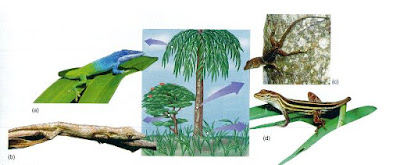How species evolve to occupy different niches within anecosystem
Each organism in an ecosystem confronts the challenge of survival in a different way. As we have just discussed, the niche an organism occupies is the sum total of all the ways it uses the resources of its environment, and may be described in terms of space utilization, food consumption, temperature range, appropriate conditions for mating, requirements for moisture, and other factors. Niche is not synonymous with habitat, the place where an organism lives. Habitat is a place, and niche is a pat-tern of living. Many species can share a habitat, but as we shall see, no two species can long occupy exactly the same niche.
Competition is the struggle of two organisms to use the same resource when there is not enough of the resource to satisfy both. When two species compete for the same resource, the species that utilizes the resource more efficiently will eventually out-compete the other in that location and drive it to extinction there. Ecologists call this the principle of competitive exclusion: no two species with the same niche can coexist. Persistent competition between two species is rare in nature. Either one species drives the other to extinction, or natural selection favors changes that reduce the competition between them. In resource partitioning, species that live in the same geographical area avoid competition by living in different portions of the habitat or by using different food or other resources. The rather exotic blue species in the upper left of the figure lives high in the tree, where it doesn't need to compete for food and space with the dark brown species in the upper right that lives on the tree's trunk.

The changes that evolve in two species to reduce niche overlap—that is, to lessen the degree to which they compete for the same resources—arc called character displacements. Character displacement can be seen clearly among Darwin's finches. The two Galapagos finches have beaks of similar size when each is living on an island where the other does not occur. On islands where they am found living together, the two species have evolved beaks of different sizes, one adapted to larger seeds, the other to smaller ones. In essence, the two finches have subdivided the food niche, creating two new smaller niches. By partitioning the available food resourc
es, the two species have avoided direct competition with each other, and so are able to live together in the same habitat.

No comments:
Post a Comment